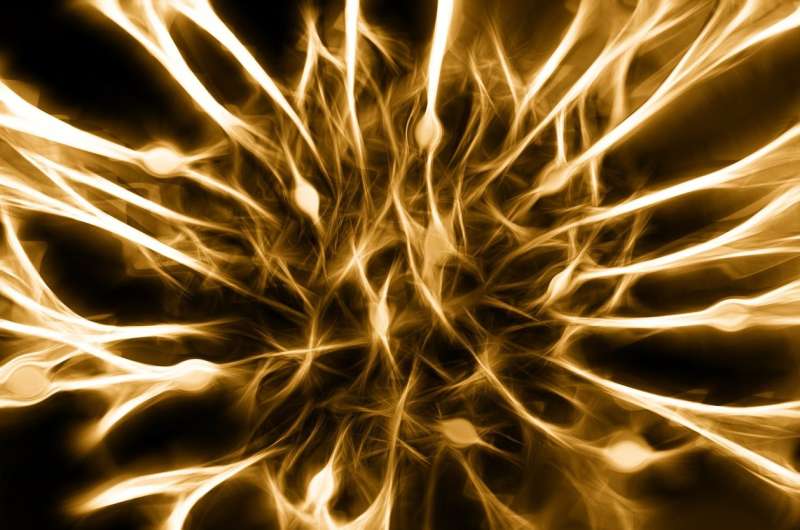Neuroscientists reveal link between cell 'dark matter' and chronic nerve pain

A study, which has revealed the link between neuropathic pain and 'dark matter' in cells, could pave the way for new treatments for patients suffering with chronic nerve pain.
The research by the University of Sheffield has shown for the first time a significant correlation between neuropathic pain and the abundance of specific RNA molecules (microRNA) present in patients following lingual nerve injury.
The study has now sparked a new phase of research where neuroscientists at the University's School of Clinical Dentistry will explore how these microRNA—which are part of the non-protein coding 'dark matter' of the cell—contribute to the development and maintenance of chronic neuropathic pain.
It is hoped this research, published in Molecular Pain, will go on to inform the potential discovery of new treatments to reduce or stop patients experiencing this pain altogether.
The trigeminal nerve provides sensation to the mouth and face, and although rare, injury to this nerve can occur during a variety of clinical procedures such as wisdom tooth removal, the placement of dental implants or as a result of facial fractures or trauma.
Following a nerve injury, patients can be left with altered sensation including severe nerve pain (neuropathic pain) and this can affect a person's ability to speak, eat and taste.
Previous treatment options had poor outcomes for patients, but over the last 20 years the Sheffield team has pioneered the development of reliable and successful methods for trigeminal nerve repair. The School of Clinical Dentistry is now the lead institute in the UK to offer such trigeminal nerve repair treatments and has published protocols for the clinical management of trigeminal nerve injuries.
However, for some patients neuropathic pain can persist after surgery, and this is extremely difficult to treat.
The team at Sheffield have been working to understand why, with the help of a unique bank of human tissue consisting of injured portions of nerves collected from those patients who have undergone a surgical repair. These samples are crucially linked to a detailed pain history and functional record for each patient, which has allowed the team to look into possible causes of the pain explored in their new study.
The correlation between the levels of specific microRNAs and neuropathic pain found in the study suggest that following a lingual nerve injury, there is a contribution of specific microRNAs to the development of chronic neuropathic pain.
"For people living with chronic neuropathic pain, the impact can be devastating," said Fiona Boissonade, Professor of Neuroscience at the University of Sheffield. "For the group of patients experiencing this problem the symptoms can be debilitating, having a profound effect on a range of normal everyday activities such as speaking and eating. The consequences of this can also have a considerable impact on quality of life; affecting the ability to work or even socialise with friends and family."
Dr. Dan Lambert, Reader in Molecular Cell Biology at the University of Sheffield and co-author of the study, said: "MicroRNA, a type of RNA discovered less than 20 years ago in humans, hold great promise as a source of new treatment targets in several diseases. The discovery that specific microRNA are associated with chronic neuropathic pain is very exciting."
"Little can be offered to these patients by standard clinical practice, either in terms of a clear prognosis or possible further surgical intervention to improve the level of recovery," said Dr. Simon Atkins, Consultant Oral Surgeon leading the trigeminal nerve repair team.
He added: "Although some medications are available, they often fail to improve this neuropathic pain and can produce very unpleasant side effects like drowsiness or dizziness. Unfortunately at the moment this kind of chronic pain is not curable, which makes finding a treatment all the more imperative."
The study has sparked a new phase of research, funded by the Biotechnology and Biological Sciences Research Council and the pharmaceutical company Eli Lilly, which partners with public bodies to discover, develop, and deliver innovative new pharmaceutical therapies to improve patient outcomes. This includes novel approaches to treat chronic neuropathic, musculoskeletal and visceral pain.
Over the next four years, Professor Boissonade and her team aim to investigate how these relevant microRNA molecules in and around the nerves might be influencing the amount of pain patients experience; and how controlling levels of these molecules influences pain.
"The new research will help us understand how chronic neuropathic pain develops and is maintained, and help us generate potential new treatments to reduce pain in those who experience it," said Professor Boissonade.
"Chronic neuropathic pain can affect any type of nerve and can also affect patients following chemotherapy, those who have had amputations, or people living with diabetes for example. So this research provides a great example of how basic neuroscience research can be translated to the clinic, having the potential to affect a wide range of people and improving their quality of life; not just those with trauma to their trigeminal nerve."
More information: Diana Tavares-Ferreira et al. Correlation of miRNA expression with intensity of neuropathic pain in man, Molecular Pain (2019). DOI: 10.1177/1744806919860323

















